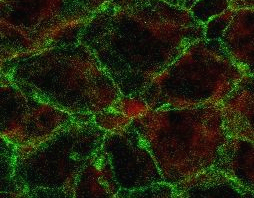

Image from a confocal microscope showing so-called pin-wheel structure of the lateral wall of the lateral ventricle: ENaC-positive adult neural stem cell (red) surrounded by ependymal cells.
Source: Helmholtz Zentrum München
The ancient Greek aphorism panta rhei means “everything flows”, a phrase used by philosophers to describe the constant flux and interplay between the past and renewal.
A recent paper lends this relationship a whole new meaning: a team of researchers headed by Professor Magdalena Götz and their collaborators from the LMU (Prof. Benedikt Grothe) and the Henrich-Heine University Düsseldorf have discovered that the flow of cerebrospinal fluid is a key signal for neural stem cell renewal.
“Neural stem cells in the brain can divide and mature into neurons and this process plays important roles in various regions of the brain – including olfactory sense and memory,” explains Magdalena Götz, Director of the Institute for Stem Cell Research at Helmholtz Zentrum München and professor at the Institute for Physiological Genomics at the Biomedical Center of LMU.
“These cells are located in what is known as the neurogenic stem cell niche one of which is located at the walls of the lateral ventricles*, where they are in contact with circulating cerebrospinal fluid.”
The cerebrospinal fluid fills the brain and its roles are still ill understood. This work highlights the role of this fluid as a key signal – but this time not a chemical but a physical signal. Götz and her team, under the guidance of lead author Dr. David Petrik, discovered that brain stem cells are also influenced by the physical forces of the fluid flow.
Channel protein plays a key role
“The whole mechanism is controlled by the ENaC molecule,” Petrik explains. This abbreviation stands for epithelial sodium (Na) channel and describes a channel protein on the cell surface through which sodium ions stream into the cell’s interior. “We were able to show in an experimental model that brain stem cells are no longer able to divide in the absence of ENaC. Conversely, a stronger ENaC function promotes cell proliferation.”
Further tests showed that the function of ENaC is augmented by shear forces exerted on the cells by the cerebrospinal fluid. The physical stimulation causes the channel protein to open for longer time and allow sodium ions to flow into the cell, thus stimulating division.
“The results came as a big surprise, since ENaC had previously only been known for its functions in the kidneys and lungs,” says study leader Götz. She and her team now want to better explore the fast signals mediated by ions in stem cells and clarify the extent to which the findings are also relevant to treatment. After all, pharmacological ENaC blockers are already used clinically to relieve certain types of hypertension. Now it is known that they can also influence stem cells in the brain and thus brain function. Here, too, research is in constant flow: panta rhei
Further Information
* The ventricular system is a set of four interconnected cavities (ventricles) in the brain, where the cerebrospinal fluid (CSF) is produced.
Background:
Co-author Melanie Pusch is participant in the Helmholtz Graduate School Environmental Health doctoral education program, or HELENA for short.
Original-Publikation:
Petrik, D. et al. (2018): Epithelial Sodium Channel Regulates Adult Neural Stem Cell Proliferation in a Flow-Dependent Manner. Cell Stem Cell, DOI: 10.1016/j.stem.2018.04.016
The Helmholtz Zentrum München, the German Research Center for Environmental Health, pursues the goal of developing personalized medical approaches for the prevention and therapy of major common diseases such as diabetes and lung diseases. To achieve this, it investigates the interaction of genetics, environmental factors and lifestyle. The Helmholtz Zentrum München is headquartered in Neuherberg in the north of Munich and has about 2,300 staff members. It is a member of the Helmholtz Association, a community of 18 scientific-technical and medical-biological research centers with a total of about 37,000 staff members.
The Institute of Stem Cell Research (ISF) investigates the basic molecular and cellular mechanisms of stem cell maintenance and differentiation. From that, the ISF then develops approaches in order to replace defect cell types, either by activating resting stem cells or by re-programming other existing cell types to repair themselves. The aim of these approaches is to stimulate the regrowth of damaged, pathologically changed or destroyed tissue.
As one of Europe's leading research universities, LMU Munich is committed to the highest international standards of excellence in research and teaching. Building on its 500-year-tradition of scholarship, LMU covers a broad spectrum of disciplines, ranging from the humanities and cultural studies through law, economics and social studies to medicine and the sciences. 15 percent of LMU‘s 50,000 students come from abroad, originating from 130 countries worldwide. The know-how and creativity of LMU's academics form the foundation of the University's outstanding research record. This is also reflected in LMU‘s designation of as a “university of excellence” in the context of the Excellence Initiative, a nationwide competition to promote top-level university research. http://www.en.lmu.de
Contact for the media:
Department of Communication, Helmholtz Zentrum München – German Research Center for Environmental Health, Ingolstädter Landstr. 1, 85764 Neuherberg, Tel. +49 89 3187 2238, E-mail: presse@helmholtz-muenchen.de
Scientific Contact:
Prof. Dr. Magdalena Götz, Helmholtz Zentrum München – German Research Center for Environmental Health, Institute of Stem Cell Research, Ingolstädter Landstr. 1, 85764 Neuherberg, Tel. +49 89 3187 3750, E-mail: magdalena.goetz@helmholtz-muenchen.de












